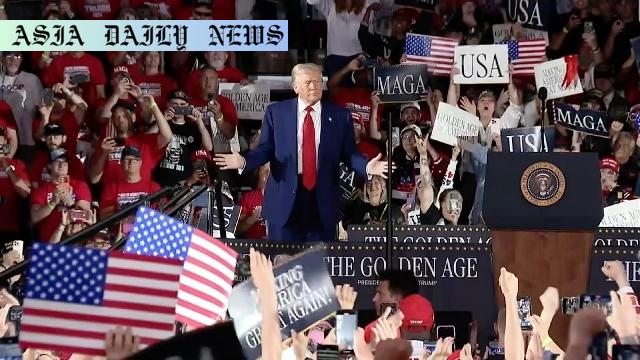Trump Rally: US President Donald Trump emphasizes achievements in illegal immigration control, tariffs, and American job protection.
Trump marked his 100th day in office with a rally in Michigan.
Achievements highlighted include immigration control, tariffs, and job creation.
Calls for further vehicle manufacturing in the US.
Focus on tax cuts and deep reforms in Washington.

Marking 100 Days: An Event of Reflection and Pride
On the 100th day of his presidency, Donald Trump held a rally in a suburb of Detroit, Michigan, where he passionately addressed his accomplishments in office. The event was a moment of self-reflection on the progress made in critical areas such as illegal immigration, job creation, and his ongoing efforts to regulate tariffs. Calling his administration’s first 100 days “the most successful” in history, Trump sparked both applause and debate among his supporters and critics.
Trump’s rally underscored Michigan’s pivotal role as a key swing state during the 2016 election and the importance of Detroit in the American auto manufacturing sector. With supporters gathered, Trump’s emphasis on restricting illegal immigration and tackling tariff regulations resonated strongly in an area where industrial job security remains a shared concern. His speech specifically aimed to highlight how his policies cater to bolstering American industries and workers while safeguarding their interests.
Key Actions: Immigration, Tariffs, and Economic Reform
Illegal immigration once again took center stage as Trump reiterated claims of steady progress in tightening border controls. Citing administrative decisions to end “week-by-week” illegal crossings, Trump framed his policy shift as a decisive step in reclaiming domestic opportunities for American workers. The theme of “jobs for Americans” extended to his outlined plans for reducing Japanese car imports, which he argued disproportionately hurt domestic automakers.
Another policy highlighted in Trump’s speech involved comprehensive economic reforms. From revising government programs to proposing federal workforce reductions, Trump emphasized his focus on streamlining Washington. By boasting measurable progress within just his first 100 days, Trump worked to command credibility in his broader economic agenda. His call for bringing foreign automakers physically into U.S. markets doubled as a promise to redirect American manufacturing back onto American soil.
A Future Vision: Tax Reform, Investment, and Industry Reconstruction
Toward the conclusion of his speech, Trump sought momentum for tax cuts that would invigorate the nation’s economy. Stressing the importance of creating space for local business investments, he connected these reforms to his ongoing agenda: bolstering the automotive industry and revitalizing broader manufacturing jobs across the United States. This message likely resonated well with Michigan’s workforce, as those reliant upon auto industry jobs are among the core constituencies he pledged to protect.
The focus on tariffs promised future discussions likely to explore whether measures to strengthen economic independence directly correlate with immediate consumer benefits. Trump called the rallies a moment to re-ignite voter belief by tying policies closely to improving employment rates and middle-class wealth growth. Ending an inspiring night, his iconic slogan punctuated optimism: “We will make America great again.”



Commentary
Understanding the Impact of Trump’s First 100 Days
Donald Trump’s rally marking his 100th day in office was a unique moment to reflect on the promises, accomplishments, and challenges faced during his presidency thus far. The Michigan rally served both as a commendation of perceived success and as a platform to renew connections with the American workers and voters who propelled him into office. By choosing Detroit, the nerve center of the U.S. auto industry, Trump effectively spotlighted his agenda of reviving American manufacturing and reducing external dependence.
It was particularly interesting to see how Trump tied immigration policies into his broader economic narrative. The connection he drew between controlling illegal border crossings and securing jobs for American workers is a theme that many supporters passionately endorse. However, it remains open to interpretation whether these policies alone suffice for addressing systemic challenges like wage stagnation and global competitiveness. This rally provided more insights into the president’s broader vision of economic nationalism.
An Economic Equation: Bringing Jobs, Policies, and People Together
What stood out most was the president’s emphasis on shifting foreign car production to the U.S. This highlighted a strong investment in tariffs as a policy tool to protect American industries from foreign competition. While this undoubtedly appeals to local workers, questions about global backlash or economic adjustments loom large. Industries like automobile manufacturing face intricate supply chain relations that cannot simply be solved by regionalizing operations.
Nevertheless, Trump’s ability to simplify these topics into accessible rhetoric is a hallmark of his communication strategy. When he connects policies directly to middle-class American prosperity, his approval spikes. However, these plans must be accompanied by a clear understanding of their implementation costs and potential ripple effects internationally. As a globalized nation, America cannot entirely isolate its manufacturing sector without considering pushback.